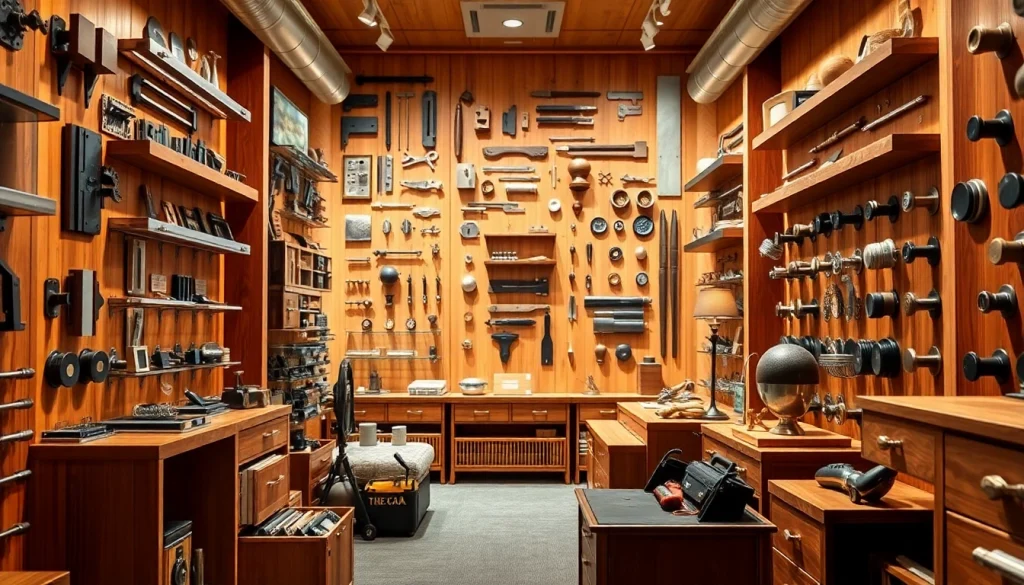
Understanding Furniture Hardware
What is Furniture Hardware?
Furniture hardware encompasses a range of components used in the construction, functionality, and aesthetics of furniture pieces. It includes items such as hinges, knobs, handles, drawer slides, and other fittings that play critical roles in both the usability and appearance of furniture. Furniture hardware not only facilitates movement and access within furniture (like drawer slides or cabinet hinges) but also contributes to its overall style and design.
Types of Furniture Hardware
The market offers a variety of hardware types tailored for different furniture needs. These can broadly be classified into:
- Hinges: Essential for doors and lids, providing movement and accessibility.
- Drawer Slides: Allow for smooth opening and closing of drawers, and come in varying lengths and weight capacities.
- Knobs and Pulls: Aesthetic handles that enhance the look of cabinets and drawers while serving functional roles.
- Legs and Bases: Provide stability and support for various furniture pieces, available in numerous styles to suit different designs.
- Catches and Latches: Used to secure doors or lids in closed positions, offering both safety and convenience.
- Corner Braces and Anchors: Structural supports that enhance the durability of furniture pieces.
Importance in Furniture Design
Furniture hardware is not merely utilitarian; it plays a vital role in design integrity and overall aesthetics. Effective use of hardware can elevate furniture from generic to sophisticated, introducing unique character through design choices. Furthermore, hardware can also dictate functionality based on the intended use—heavier duty hardware is necessary for frequently used pieces, while lighter styles may be suitable for ornamental furniture.
Choosing the Right Suppliers
Factors to Consider When Selecting Suppliers
When sourcing hardware, the selection of the supplier is critical. Key factors include:
- Reputation: Known suppliers with established reputations in the industry often guarantee reliability and product quality.
- Product Range: A broader catalog allows designers and craftsmen flexibility in their design options.
- Pricing: Competitive pricing is essential, but it should not compromise the quality of materials.
- Availability: The supplier’s ability to fulfill orders promptly can affect project timelines significantly.
- Customer Service: Strong customer support is crucial for resolving issues, obtaining product information, and receiving timely assistance.
Evaluating Quality and Durability
Quality is paramount when selecting furniture hardware as it impacts functional longevity. Factors to assess include:
- Material Selection: Hardware made from durable materials such as stainless steel or high-quality plastics often withstand wear and tear better than lower-quality alternatives.
- Testing Standards: Reputable suppliers often provide certification of performance under various conditions, illustrating durability.
- Finish Quality: A properly applied finish protects the hardware from corrosion and scratches, both of which can significantly diminish appearance and functionality over time.
Comparing Supplier Catalogs
A thorough comparison of supplier catalogs can reveal a wealth of options catered to various design preferences and functional requirements. Here are some strategies:
- Organize by Category: Start by grouping hardware types—knobs, slides, hinges—then assess suppliers for each category.
- Create a SWOT Analysis: Identify strengths, weaknesses, opportunities, and threats for each supplier to aid in quantifying their offerings and market position.
- Sample Orders: Request samples for hands-on evaluation of quality, which can help inform final decisions based on tactile experience.
Top Furniture Hardware Suppliers in the Market
Feature: Market Leaders
Several key suppliers have established their dominance in the furniture hardware market due to their extensive ranges and high standards. Here are a few:
- Rockler: Known for an extensive selection of hardware, Rockler excels in drawer slides, hinges, and decorative cabinet handles, making it a go-to for both professionals and DIYers.
- Woodcraft: With a diverse catalog that includes traditional and vintage styles, Woodcraft supplies a variety of hardware items suitable for numerous furniture styles.
- Richelieu: A leader in functional and specialty hardware, Richelieu offers innovative solutions that cater to the woodworking industry’s unique needs.
Emerging Suppliers
As market demands shift, new suppliers are continuously emerging with niche offerings and unique products. When exploring emerging suppliers, consider their strengths:
- Innovative Designs: New suppliers often focus on trends and introduce unique hardware that may not be available in established catalogs.
- Customization Options: Many new entrants allow for customization, enabling clients to choose sizes, finishes, and even materials for a tailored look.
Regional Insights
Different regions may present unique challenges and opportunities when it comes to sourcing furniture hardware:
- Local Materials: Sourcing suppliers that offer locally-made hardware can be both cost-effective and reduce shipping distances, contributing to sustainability.
- Regulatory Standards: Be aware of regional regulations regarding furniture safety and quality standards that suppliers must comply with, which can influence choice.
Integrating Hardware in DIY Projects
Step-by-Step Hardware Installation
Installing furniture hardware may seem daunting initially, but following a systematic approach can lead to success. Here’s a simple guide:
- Preparation: Gather necessary tools such as screwdrivers, drills, and measuring tape. Make sure to have all parts ready.
- Mark Placement: Use a pencil to lightly mark where hardware will be installed for accuracy.
- Drill Holes: Carefully drill holes at the marked locations, ensuring they are evenly spaced and at the correct depth.
- Attach Hardware: Align the hardware with the drilled holes and secure with screws. Ensure everything is tightened to avoid looseness.
- Test Functionality: Once installed, test the hardware for smooth operation and alignment.
Common Mistakes to Avoid
Avoiding pitfalls can be as crucial as mastering installation steps. Consider these common mistakes:
- Ignoring Measurements: Double-checking dimensions helps prevent misalignment and damage.
- Using Incorrect Tools: Ensure the right tools are employed for specific hardware types to avoid stripping screws or damaging components.
- Neglecting Aesthetics: Always evaluate how the hardware matches the overall style of the furniture for a cohesive look.
Innovative DIY Ideas with Hardware
Creative use of hardware in DIY projects can personalize a space immensely. Consider these ideas:
- Bathroom Upgrades: Swap out standard cabinet knobs and pulls with vintage-style options for an instant facelift.
- Custom Drawer Slides: Use soft-close slides in kitchen drawers to combine function with luxury.
- Repurposing Hardware: Transform old furniture legs into stylish plant stands or shelving units.
Future Trends in Furniture Hardware
Eco-Friendly Alternatives
As environmental awareness grows, the demand for eco-friendly hardware options has risen. Suppliers are responding by offering hardware made from sustainable materials and finishes that reduce environmental impact without compromising quality. Look for suppliers that emphasize sustainability in their product lines, as these components can attract environmentally conscious consumers.
Smart Hardware Technology
The integration of technology into hardware represents a burgeoning trend. Smart locks, sensor-operated hinges, and integrated lighting are just a few examples of how technology is transforming traditional furniture hardware. As consumers prioritize convenience and technological features, suppliers who embrace smart innovations will likely find greater market success.
Design Trends to Watch
On the design front, emerging trends can significantly influence hardware choices. For instance, minimalistic designs emphasizing clean lines and muted colors are gaining popularity, necessitating hardware that aligns with these aesthetics. Additionally, vintage and retro styles continue to inspire offering timeless looks that complement modern decor.
In conclusion, the world of furniture hardware is diverse and dynamic, offering a wealth of options for design professionals and DIY enthusiasts alike. By understanding the nuances of hardware types, supplier selections, and current trends, you can elevate your furniture projects, enhance functionality, and create aesthetically pleasing pieces that stand the test of time. For those seeking reliable and innovative furniture hardware suppliers, exploring the market with a critical eye can lead to successful outcomes in both design and functionality.





